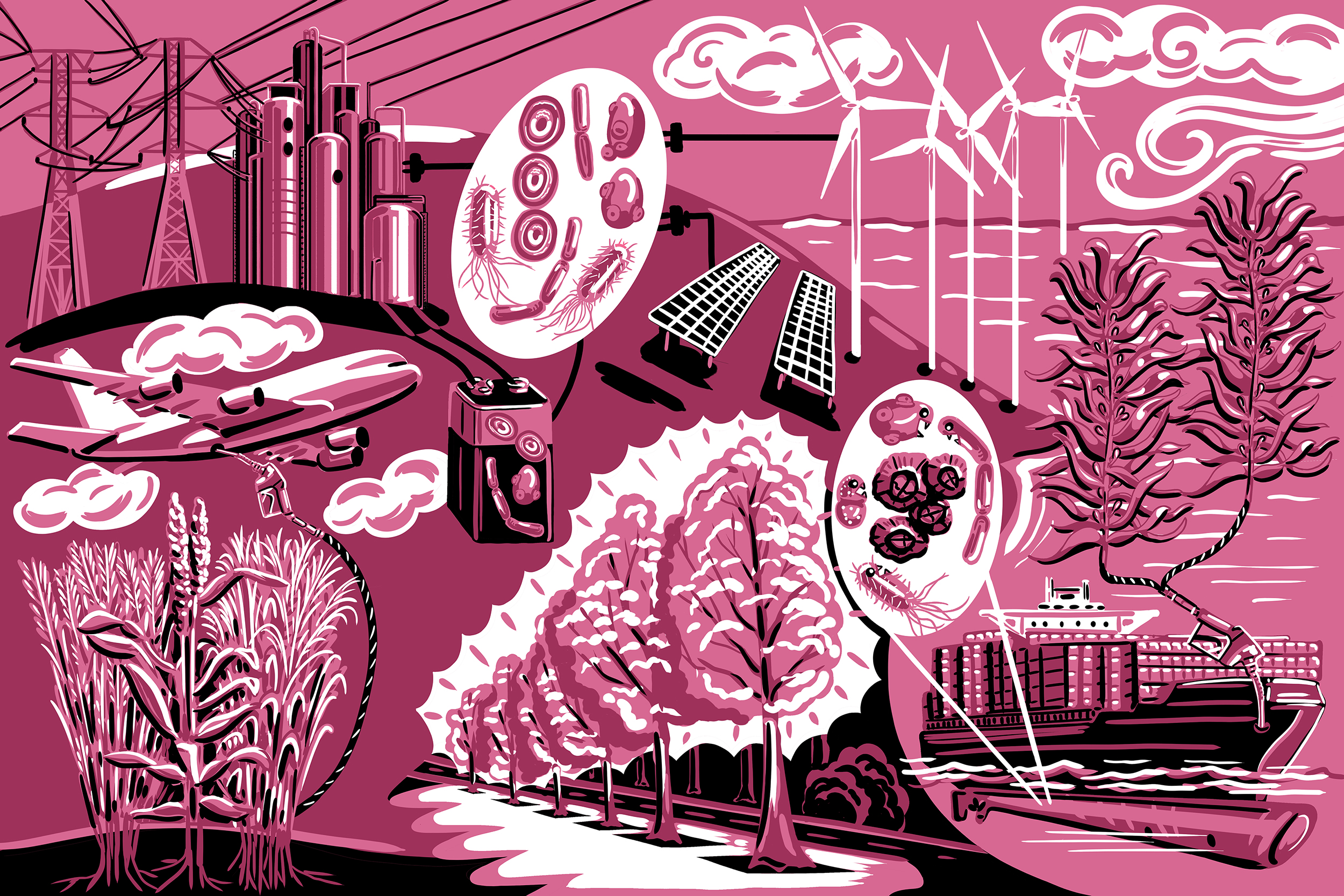Transportation & Energy
Transportation & Energy addresses engineering biology opportunities in biofuels, electricity production and storage, and reducing emissions from transportation, shipping, and aviation.
Transportation & Energy addresses engineering biology opportunities in biofuels, electricity production and storage, and reducing emissions from transportation, shipping, and aviation.
Together, transportation and energy production account for the vast majority of harmful greenhouse gas (GHG) production, including well more than half of the world’s CO2 production (data from https://www.climatetrace.org/explore). This roadmap’s Transportation & Energy theme addresses engineering biology opportunities to shift these sectors towards sustainable, renewable fuels and energy sources, while also highlighting opportunities that will improve efficiencies during the transition to carbon-negative sources of energy.

Improving efficiency and sustainability in transportation and energy with engineering biology. While biofuels are one of the most recognizable uses of engineering biology, many other opportunities exist for biotechnology to reduce the impact of the energy and transportation sectors on climate change and to contribute to long-term sustainability. Engineering biology could revolutionize energy storage technologies, turning us away from environmentally-hazardous, and economically unsustainable, rare-earth batteries and enabling a “green” solution to storage of excess electricity from wind and solar. Advancements in microbial fuel cell technology could also enable wide-scale generation of electricity from biological systems. Progress is needed to increase the energy-density of fuel from biological feedstocks and to better capture and utilize organismal electron-transfer. For a different approach at reducing energy use, transportation efficiency could be improved with biomaterials and bio-derived coatings, such as biocoatings for ship hulls to reduce fouling and barnacle build-up, reducing friction and fuel utilization.
While there are existing solutions for carbon-free transportation (i.e., electric vehicles), engineering biology could play a key part in decarbonizing aviation, marine shipping, and heavy duty transport by enabling the production of low-emissions, energy-dense biofuels including sustainable aviation fuels (SAF).1Reinders, S. (2022). Berkeley Lab scientists create energy-dense biofuel. Retrieved August 26, 2022, from View Publication.,2Tan, E. C. D., Hawkins, T. R., Lee, U., Tao, L., Meyer, P. A., Wang, M., & Thompson, T. (2021). Biofuel Options for Marine Applications: Technoeconomic and Life-Cycle Analyses. Environmental Science & Technology, 55(11), 7561–7570. View Publication. These fuels are made from biomass or other feedstocks (including carbon oxides, see Lanzajet, 20223LanzaJet. (2022). Someday is Now. LanzaJet. Retrieved August 22, 2022, from https://www.lanzajet.com/) for use as “drop-in” fuels for incumbent engines.4Balcombe, P., Brierley, J., Lewis, C., Skatvedt, L., Speirs, J., Hawkes, A., & Staffell, I. (2019). How to decarbonise international shipping: Options for fuels, technologies and policies. Energy Conversion and Management, 182, 72–88. View Publication. Assessments of the sustainability of such biofuels should incorporate: i) the potential for bioenergy feedstocks to compete with food crops for land and water use and ii) the capacity to make fuels sufficiently energy-dense, such that they are economical. This roadmap includes improving carbon utilization of feedstocks and enabling fuel production in closed-loop systems where all available carbon is captured. Another opportunity is to leverage advancements in biomaterials for surfaces and coatings that reduce friction and improve efficiency, reducing subsequent fuel expenditure.
Electricity generation is the second leading contributor to GHG production in the United States.5EPA. (2015). Sources of Greenhouse Gas Emissions [Overviews and Factsheets]. View Publication. As we turn to more renewable energy sources — such as wind, solar, and even the production of electricity from biology — sustainable energy storage technologies are becoming increasingly important. Advancements in engineering biology can enable bio-batteries and biobased fuel cells that are far more sustainable and climate-friendly than nearly all current battery technologies. This roadmap also addresses biotechnology opportunities to convert excess electricity produced by renewable resources at times of low demand into other value-added chemicals, materials, and products.
EBRC’s 2019 roadmap, Engineering Biology: A Research Roadmap for the Next-Generation Bioeconomy, includes approaches to advance biotechnology for transportation fuels, and other energy sources, including electricity. These primarily focus on efficiency of feedstocks and biomass for energy production and efforts to reduce global energy consumption, such as by developing bioprocesses to obtain energy from currently untapped sources.
View →